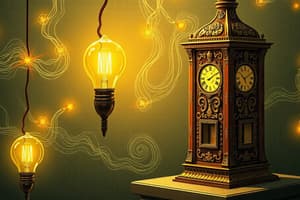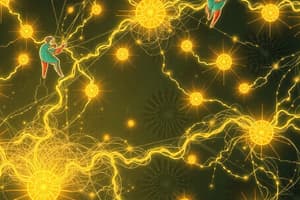Podcast
Questions and Answers
Describe the 3 rules of charge.
Describe the 3 rules of charge.
Opposite charges attract each other, like charges repel each other, and charged objects attract neutral objects.
What is Ohm's Law?
What is Ohm's Law?
V = IR
Differentiate between the effects of an open vs closed circuit.
Differentiate between the effects of an open vs closed circuit.
A closed circuit allows current to flow, while an open circuit prevents current from flowing.
List the two ways to increase the strength of an electromagnet.
List the two ways to increase the strength of an electromagnet.
Explain the relationship between electricity and magnetism.
Explain the relationship between electricity and magnetism.
Differentiate between magnetic domains in magnetic vs non-magnetic elements.
Differentiate between magnetic domains in magnetic vs non-magnetic elements.
Explain the relationship between magnetic fields and magnetic force.
Explain the relationship between magnetic fields and magnetic force.
What are ferromagnetic materials?
What are ferromagnetic materials?
Define a magnetic field.
Define a magnetic field.
What is a magnet?
What is a magnet?
What is a voltmeter?
What is a voltmeter?
Explain the relationship between voltage, current, and resistance in a circuit.
Explain the relationship between voltage, current, and resistance in a circuit.
Describe the factors that affect resistance.
Describe the factors that affect resistance.
What is static electricity?
What is static electricity?
What is an electroscope?
What is an electroscope?
Define an insulator.
Define an insulator.
What is static discharge?
What is static discharge?
What is grounding?
What is grounding?
Explain how a battery works.
Explain how a battery works.
What is resistance?
What is resistance?
Define voltage difference.
Define voltage difference.
What is current?
What is current?
Explain the three ways charge can be transferred.
Explain the three ways charge can be transferred.
Flashcards are hidden until you start studying
Study Notes
Rules of Charge
- Opposite charges attract each other.
- Like charges repel each other.
- Charged objects attract neutral objects.
Ohm's Law
- Electric current is proportional to voltage and inversely proportional to resistance.
- Formula: V = IR.
Open vs. Closed Circuit
- A closed circuit allows current to flow through a complete path.
- An open circuit has a break preventing current flow, leading to infinite impedance.
Strength of Electromagnets
- Increase strength by adding more wire loops around the iron core.
- Boost strength by increasing current or voltage.
- Temporary magnets can be made by stroking iron/steel with a permanent magnet.
Relationship Between Electricity and Magnetism
- Involves attraction and repulsion of charged particles.
- Interactions are termed electromagnetism.
- Movement of magnets can generate electricity, while electricity can create magnetic fields.
Magnetic Domains
- Magnetic materials align their magnetic domains, responding to external magnetic fields.
- Non-magnetic materials have randomly arranged domains and do not respond to magnetic fields.
Magnetic Fields and Force
- Magnetic force is the attraction or repulsion between charged particles in motion.
- Force on a charge is influenced by the magnetic field produced by another moving charge.
Ferromagnetism
- Refers to metal alloys attracted to magnets or those which can become permanent magnets.
Magnetic Field
- A region surrounding magnetic materials or a moving electric charge where magnetic forces act.
Magnet
- Material that attracts iron and its alloys.
Voltmeter
- Device used to measure voltage or electrical potential difference.
Voltage, Current, and Resistance
- Defined by Ohm's Law: I = V/R.
- Current is directly proportional to voltage and inversely proportional to resistance.
Factors Affecting Resistance
- Type of material (resistor composition).
- Length of the resistor.
- Thickness of the resistor.
- Temperature of the conductor.
Static Electricity
- Electric charge that remains at rest, usually produced by friction or induction.
Electroscope
- Tool for detecting electric charges, featuring a metal knob and two thin leaves.
Insulator
- Material that does not easily allow heat or electrons to move through it.
Static Discharge
- Loss of static electricity when charges transfer between objects.
Grounding
- Provides a path for electric charges to move freely to the ground.
How Batteries Work
- Convert stored chemical energy into electrical energy.
Resistance
- Opposition of a material to electric current flow; measured in Ohms.
Voltage Difference
- Drives the flow of electric charges; measured in volts.
Current
- The flow of electric charge, represented by the symbol (I), measured in Amps.
Charge Transfer Methods
- Charges can be transferred via friction, conduction, or induction.
Studying That Suits You
Use AI to generate personalized quizzes and flashcards to suit your learning preferences.




